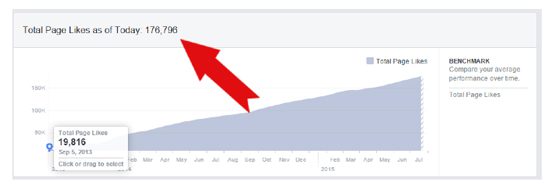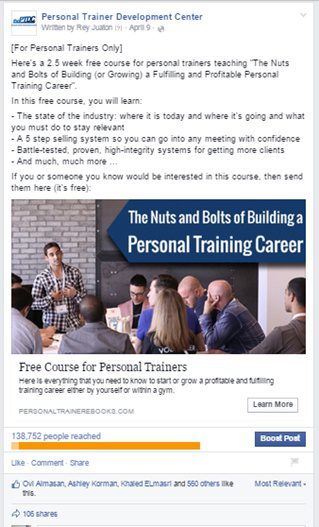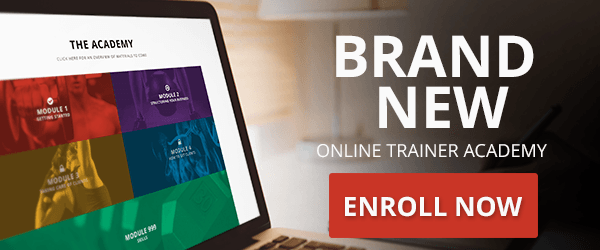
- You only need 1000 true fans.
Once you get 1000 true fans that will buy all of your products or want to be your client, you will never need to advertise or market yourself again. Ever. These 1000 true fans are already on Facebook waiting for you to find them. Your goal is to find them.
- Never Use Boost Post.
Clicking the “Boost Post” button on a Facebook Page Post is not a good Facebook advertising strategy. It’s Facebook’s method for getting fan pages to spend money to get their posts seen. It’s not a good method for building a following and making money through Facebook advertising.
- Advertising on Facebook is cheap.
If there’s one place to get cheap traffic to your website or Facebook page, it’s through Facebook Advertising. Even with Facebook’s most recent update, it’s possible to get Website Clicks for 7 cents, Page Likes for 20 cents, and Client Leads for 54 cents.



- Always be direct.
The only goals you will ever want to use your Facebook advertising for are: getting page likes, adding emails to your email list, and making sales. Nothing else matters.
- Tracking success is crucial.
Facebook allows you to simply and easily add tracking pixels to your website so you will know which of your advertisements are working, and which ones are stale. The advertising process is iterative, and if you don’t know what’s working, then you’ll never have continued success.
- Targeting is precise.
You can target clients and buyers based on their location, demographics, interests, pages they like, behaviours, profession, what kind of car they drive, and even their purchasing behaviours. If you run a local fitness business, you can target only people who live in your city/town.
- You can advertise to your mailing list.
Facebook’s back-end advertising software allows you to upload a list of emails or phone numbers and show ads to only these people. If you’re running a promotion via email, you can also run the promotion to these same people when they log onto Facebook.
- Your customer list can be cloned and multiplied by 200,000%.
You can upload your customer list, or tag buyers when they visit a certain web page on your website. Facebook builds an ongoing list. You can then get Facebook to multiply it with one click of a button, creating a Lookalike Audience. This audience has the exact same demographics and behaviours as your current list, and you can now show advertisements to them. This is helpful as it allows you to find more clones of your ideal client or customer.
- You can advertise to people who have visited your website.
Each time someone visits your website, you can allow Facebook to recognize this and add them to a list. In turn, you can show advertisements directly to this list of people. Amazon uses this method. Each time you view a product on their website, you will see an advertisement for the exact product the next time you log onto Facebook. You can use this method as well and it costs next to nothing.
10 Return on investment (ROI) can be as high as 43,441%.
During product launches, you can get a very high ROI due to the fact that advertising is so cheap and targeted, especially if you’re selling a high priced product or program, and have already built your following of 1000 true fans.
Conceal advertisements in the Facebook News Feed.
You can create advertisements that look almost exactly like Facebook page posts. This allows your advertisements to blend in and get read and clicked on.
In the image above, you’ll see an ad that we’ve been running for the Personal Trainer Development Center. It looks like a standard Facebook status update, but it’s actually an advertisement. There are already 563 likes and 106 shares, and it’s an advertisement.
Take a second to think about how powerful this is. When you see an advertisement in a magazine, you don’t photocopy it and share it with all your friends, but on Facebook, this is what happens.

In the image above, you’ll see an ad that we’ve been running for the Personal Trainer Development Center. It looks like a standard Facebook status update, but it’s actually an advertisement. There are already 563 likes and 106 shares, and it’s an advertisement.
- Make your advertisements look of high quality.
No one will become a client of yours or buy your fitness products if your advertisements have spelling and grammar mistakes, your images are distorted or pixelated, and/or your website looks ugly. Make sure that all images are of high quality and the appropriate sizes, as well as having a high quality website. Be professional.
- Use your clients’ and customers’ own language.
Use words that your clients and customers use, and speak their language. If your clients keep telling you that they want to “get toned”, you will need to say “get toned” in your Facebook advertisements. You may be cringing when you say it, but your clients and prospects will be salivating.
- Back up your claims.
In your advertising, if you claim that your clients will lose X amount of weight or gain X amount of muscle, back it up with research or a case study. Trust is imperative. Also, Facebook wants your ads to set realistic expectations. Nothing confirms these expectations by showing actual proof.
- Call out to your audience.
In Facebook advertising, it is crucial to call out to your target audience. For example, if your audience is post-natal women who want to lose fat, make sure you mention “moms who want to get in shape” in your advertisement.
- Replicate winning advertisements.
If an advertisement is performing well, and always performs well, use it as a template for future advertisements. Facebook advertising is based on human psychology, and human psychology hasn’t changed for centuries.
Interested in online training?
What Works to Build an Email List of Potential Clients and Buyers?
- Use squeeze pages.
A squeeze page is a website that trades a free product, report, advice, or an answer to a common question in exchange with the potential client or buyer’s email address. This is how you get permission to follow up with an interested party. If you do it right, it’s not spammy, and the prospect will feel goodwill for you and your services.
- Show social proof.
If you’ve been featured on TV, in a magazine, or on another website, then show it. People like to know that you are a real person doing real and amazing things. Before and after pictures work here too, as well as a high number of Facebook fans. Not only that, but Facebook shows the faces of people that your user is connected to so it's almost like friends are recommending your service for you.

- Include a benefit rich headline.
Tell your potential client or buyer how they will benefit by clicking on your advertisement. Make sure you solve a problem that they have.
- Include bullet points.
Including bullet points that show even more benefits of clicking on your advertisement will increase the potential for someone to click on it.
- Tell them what to do.
Each step of the way, tell your potential clients and buyers what to do next. In the advertisement, tell them to click. On your squeeze page, tell them to enter their email address and click the shiny orange button. This is known as the “Call to Action”.
- Hijack other peoples’ fans.
You can steal other people’s “1000 true fans” by targeting their Facebook page. For instance, if your potential clients and buyers are all personal trainers and gym owners, then you can show advertisements to people who are interested in the Personal Trainer Development Center.
- Target specific interests of people who already like your page.
Facebook categorizes peoples’ interests based on what articles they read and what Facebook pages they are a fan of. For instance, the three favourite interests of people who like the Personal Trainer Development Center are: Bodybuilding, Weight Training, and Running. Targeting your fans’ interests will allow you to find them and send them to your squeeze page.
- Encourage people to comment.
If someone comments on your advertisement, it gives it social proof. This makes your advertisement look less like spam and more like a helpful solution to your potential client or buyer’s problems.
- Target current fans.
Not everyone who likes your Facebook page will be on your email list, but you can change that. Show advertisements to current Facebook fans that are not currently on your email list. If they already like your Facebook page, it’s an easy sell to get them onto your mailing list. You can do this easily with Facebook’s Free Advertising Software.
- Use the Lookalike Audience.
If you already have a mailing list, you can find other people (who are just like people on your mailing list) and show advertisements to them, effectively multiplying your mailing list.
If you’re just getting started out, you can make a lookalike audience of everyone who clicks through your advertisement. This will increase your advertisement click through rate and decrease the amount that you’ll be paying on advertising.
What Works to Build a Facebook Fan Page of True Fans?
- Use Page Like advertisements.
This is a type of advertisement available through Facebook’s advertising software. In one short sentence, tell people to like your Facebook page and provide a benefit of doing so.

- Test different images.
Not every image you use will convert your potential fans. Try different high quality images. Do not use stock images.
- Target people who have visited your website.
If someone visits your website, get them to like your page through advertisements the next time they log onto Facebook. You can get Facebook likes for very cheap using this method.
- Use the Lookalike Audience.
If you already have a mailing list, you can find other people (who are just like people on your mailing list) and show advertisements to them, effectively multiplying your Facebook fan page.
- Target your mailing list.
If someone is already receiving emails from you, it’s easy to get them to like your Facebook fan page. Upload your current email list and show page like advertisements to people who are not already Facebook fans.












